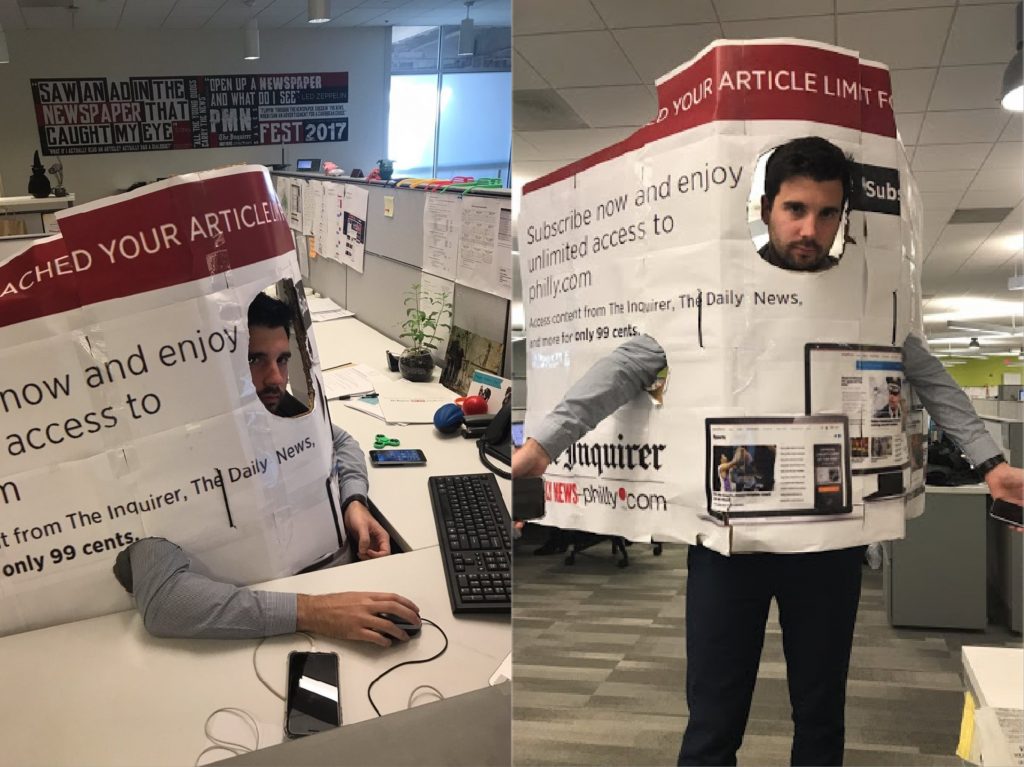Everyone loves Spotify. And how could you not? The concept of listening to whatever music you feel like, whenever you feel like it and however much you want to for a fixed monthly fee has become so popular that the number of worldwide subscribers has skyrocketed over the past few years – from 15 million paying subscribers in the beginning of 2015 to almost 83 million subscribers as of June 2018. Spotify is just one of many popular content players that show the willingness of consumers to pay for quality content – something that many newspapers have been struggling with over the last few years in their attempts of making digital profitable.
Building a Wall
With a decrease in advertising revenues, newspapers are forced to reform their digital framework. Offering online articles for free is no longer an option, yet the alternative of charging monthly or annual fees doesn’t seem too appealing to the readers. And how can you blame them? Ever since the first newspapers started publishing online, almost all articles could be accessed free of charge. Absurdly enough, people have no problem paying to buy a printed newspaper but paywalls usually cause dissent if not anger among readers. The alteration from freely accessible to paywall protected articles does not necessarily make it easier for newspapers to consolidate their position in the digital business.

Paragon New York Times
One of the forerunners regarding profitable transition from print to digital and the implementation of paywalls online is the New York Times (NYT). Out of their 3.8 million subscribers, 2.9 are digital only. The newspaper’s digital success can be traced back, among other factors, to a high level of engagement with their audience. Using customer data, the NYT strives for a better understanding of potential subscribers and their behavior towards the newspaper. With what frequency do readers visit the website? What articles do they read and what measures can be taken to make them more engaged to ultimately become paying subscribers?

A series of studies conducted by the Media Inside Project reveals readers’ motives for becoming subscribers. Among the findings is the relevance for certain preconditions that will eventually lead to subscription, such as a degree of interest in news and even more so the accuracy of news that social media often fail to provide. The final ‘hop’ over the paywall is prompted by so-called ‘trigger factors’ which can be a certain incident – a famous example is the ‘Trump-bump’ – but more commonly a promotion or a free trial.
Measuring audience engagement is at its core simple and effective, especially on the highly competitive news market. Newspapers can no longer rely on the readers coming to them but they have to meet them—three quarters of the way. Overall, focusing on subscribers certainly is a more sustainable approach to making digital profitable than trying to maximize clicks—a concept with the inherent risk of the proliferation of headline sensationalization. However, a marketing concept based on circulation revenue also entails risk, especially with regards to newspaper content.
Creating Content
Said risk comes with applying analytics to create popular content. If customer data shows a high popularity of sport articles, a strategy to increasingly cover sports is not far-fetched. Yet, such a direct response can be tricky. According to a 2017 article of the Guardian, the newspaper’s most popular article since 2010 with nearly 4,000,000 clicks deals with Edward Snowden’s activities as an NSA whistleblower. In 2017, the Economist’s third most popular article revolved around the world’s most dangerous cities and the New Yorker’s most popular piece was on the sexual assault accusations against Harvey Weinstein.
This should not in any way imply that coverage of these topics is unimportant. However, a general trend of the popularity of articles related to politics, crime, and celebrities and a following ‘over-coverage’ can be observed. Rather than letting customer data dictate topic coverage, analytics should be used by newspapers to allocate resources to content which is not as popular to make it attractive to more readers.
Quid Pro Quotability
 Readers traditionally hold a key position when it comes to the success of newspapers. This makes sense: as a journalist you can invest an immense amount of time and money into researching and writing an article but in the end, if no one is buying the finished product, you will not survive in your profession.
Readers traditionally hold a key position when it comes to the success of newspapers. This makes sense: as a journalist you can invest an immense amount of time and money into researching and writing an article but in the end, if no one is buying the finished product, you will not survive in your profession.
Perhaps the most important aspect to consider in the newspapers’ ongoing struggle for digital profitability is not to grant too much power to the reader. There is no doubt that subscribers play a vital role in the fight for survival, but rather than making the audience a content tyrant, newspaper-reader relations should be a symbiosis where in return for keeping the industry alive, newspapers provide authentic content with an added value that is worth paying for. The added value to be received are the factors of professionality and truth – something of great importance in a world of ‘fake news’ and ‘alternative facts’.
Busting the Paywall
Content-wise Spotify and online newspapers are two entirely different worlds, yet their marketing concept is pretty much identical. However, while the music streaming service seems to be perceived as the invention of the century, which listeners are more than happy to invest their money into, newspapers are struggling to gain a foothold in the world of subscriptions. For now, paywalls act more than anything as a deterrent. But the human being is a creature of habit, and time will tell whether subscription based news is a sustainable concept for digital newspapers. In the end it all comes down to people’s willingness to award the same value to authentic news as they do to good music.
By Maya Diekmann
Photo Credits
Paywall, Sofiya Ballin
new york times, samchills, CC BY 2.0
Newspaper readers, Dmitry Dzhus, CC BY 2.0
Related articles:










